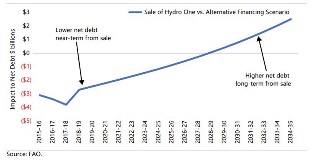Financial Accountability Office Finds Partial Sale of Hydro One Will Cost Ontarians in the Long Term

Ontario completed its final sale of Hydro One shares in December 2017, having generated an estimated $9.2 billion in proceeds by selling 53% of Hydro One. On February 12, 2018, Ontario’s Financial Accountability Office (FAO) released a report titled “Hydro One: Updated Analysis of the Partial Sale of Hydro One”, concluding that in the long run Ontarians will pay more than they will benefit from the Hydro One sale transactions. According to the FAO, the financial benefit from applying the proceeds of the sale to reduce near-term deficits and fund infrastructure will be less than the benefit from continuing to receive profits and other payments from a wholly-owned Hydro One and financing infrastructure using traditional debt.
The FAO is charged with providing independent analysis on the state of the province’s finances, trends in the provincial economy and related matters important to the Legislative Assembly of Ontario. The FAO issues reports on its own initiative, and in response to requests received from legislators. Like the FAO’s May 2017 Assessment of the Fiscal Impact of the Province’s Fair Hydro Plan (described in an earlier post), the FAO’s Updated Analysis of the Partial Sale of Hydro One was prepared in response to a request from a member of the Legislative Assembly. Consistent with the FAO’s mandate, the report makes no policy recommendations.
As described in the Updated Analysis of the Partial Sale of Hydro One report, approximately half of the proceeds from the sale of Hydro One are being applied to reduce debt associated with the former Ontario Hydro; the other half is to be used to fund infrastructure spending. Based on its own analysis, the FAO estimates that the province’s annual surplus/(deficit) will improve by a total of $3.8 billion over the fiscal years 2015-16 to 2017-18 as a result of the partial sale of Hydro One, but then will “deteriorate” by $1.1 billion for the fiscal year 2018-19, and by an average of $264 million each year from 2019-20 to 2024-25. The early benefit reflects the one-time gain from applying the sale proceeds. There will be a negative ongoing fiscal impact because the province will no longer receive 53% of Hydro One’s annual net income, and will also lose payments by Hydro One of payments-in-lieu of taxes (PILs).
While there are near-term savings associated with the Hydro One partial sale, the FAO’s analysis suggests that over the long-term it would have been cost-advantageous to retain Hydro One and instead fund infrastructure projects that will receive Hydro One sale proceeds through debt. This is illustrated in the graph below*:

The FAO’s report further explains this point as follows: “starting in 2028-29 and extending over the long-term, the FAO estimates that Provincial net debt will be higher as a result of the partial sale of Hydro One compared with the alternative financing scenario, in which the province borrowed $7.8 billion and did not sell Hydro One, as the interest savings are more than offset by forgone revenue from PILs and net income from Hydro One.”
Presumably, the FAO’s Updated Analysis of the Partial Sale of Hydro One report will be cited in the upcoming Ontario election, particularly by those who might seek to reverse the Hydro One transactions.
*Reproduced from page 13 of the FAO’s Updated Analysis of the Partial Sale of Hydro One.

